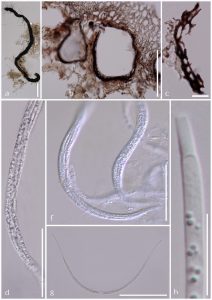Sammeyersia grandispora (Meyers) S.Y. Guo, E.B.G. Jones & K.L. Pang, Bot. Mar.: 0.1515/bot-2016-0118, 15 (2017)
Index Fungorum number: IF 820461
Saprobic on submerged mangrove wood. Sexual morph: Ascomata 100–350 × 135–300 µm, globose or subglobose to pyriform, immersed or superficial, ostiolate, with a long neck, brown to black, solitary or gregarious. Necks upto 700–800 long, cylindrical, straight or curved, sometimes two on one ascoma. Peridium 20–35 µm wide, two-layered, composed of an outer layer of textura angularis and an inner layer of elongated cells with large lumina; inner layer thickened at the base of the neck, composed of cells with thickened and highly melanized wall. Paraphyses absent. Asci 312–450 µm (x̅ = 420, n = 10), 8-spored, elongate-fusiform or cylindrical, unitunicate, thin-walled, early deliquescing. Ascospores 312–450 × 2–4 µm (x̅ = 370 × 3.8 μm, n = 10), filamentous, curved, hyaline, tapering at each end into an elongate, conical process or apical chamber, acute or rounded, filled with mucus that is released through an apical pore. Asexual morph: Undetermined.
Material examined – Thailand, Phetchaburi Province, Hat Chao Samran, 47° 72506’ E, 40° 25038’ N, 0 m asl., on intertidal decayed wood of Rhizopora sp. at a mangrove stand, 28 August 2015, M. Dayarathne CHAM005 (MFLU 16-1172).
GenBank numbers – LSU: MN592678, SSU: MN592679.
Known distribution (based on molecular data) – Belize, India, Malaysia, Taiwan (Schoch et al. 2009, Abdel-Wahab et al. 2018), Thailand (this study)
Known hosts (based on molecular data) – Avicennia marina, mangrove wood, Rhizophora apiculata, R. mucronata, Rhizophora sp., Sonneratia acida, S. apetala (Schoch et al. 2009, Jones & Pang 2012, Abdel-Wahab et al. 2018, this study)
Notes – Lulworthia grandispora is a mangrove inhabiting species, often found in tropical and subtropical countries (Jones & Pang 2012). This was synonymized to Sammeyersia grandispora and identified by the length of its ascospores, which is over 400 μm (Abdel-Wahab et al. 2017). Our new isolate (MFLU 16-1172) groups with the S. grandispora isolates deposited in the GenBank (Fig. 59). Therefore, depending on both morphological and phylogenetic data, we identified our new isolate as S. grandispora.

Sammeyersia grandispora (MFLU 16-1172, new host record). a Ascomata on wood surface. b Section through ascoma in wood. c Peridium composed of thick-walled angular cells. d, f Asci. g Filamentous ascospore. h Polar end chamber of ascospore. Scale bars: a = 500 µm, b, d–f = 100 µm, c, g = 10 µm.
